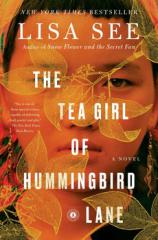Reading Group Guide
Discussion Questions
The Tea Girl of Hummingbird Lane

1. Discuss the significance of the epigraph. The Book of Songs is the oldest extant collection of Chinese poetry, written between the 7th and 11th centuries B.C.; what kind of resonance does it have today?
2. THE TEA GIRL OF HUMMINGBIRD LANE begins with the Akha aphorism, “No coincidence, no story.” What are the major coincidences in the story? Are they believable? How important are they in influencing your reaction to the novel as a whole?
3. Perhaps the most shocking moment in the novel comes with the birth of the twins and what happens to them. A-ma explains that “only animals, demons, and spirits give birth to litters. If a sow gives birth to one piglet, then both must be killed at once. If a dog gives birth to one puppy, then they too must be killed immediately.” The traditions surrounding twins are very harsh, to say the least, but were you able to understand what happens to them within the context of Akha culture? How does this moment change Li-yan’s view of Akha Law, and what are the consequences? Are there any aspects of the Akha culture that you admire?
4. What is Li-yan’s first reaction when she sees her land? Why does A-ma believe the tea garden is so important? Why does A-ma believe that the trees are sacred? What is the significance of the mother tree?
5. San-pa and Li-yan’s relationship ends tragically and causes them both great pain. Is what happens between them fate, or is it bad luck? In your opinion, does their community’s negativity about their union shape the outcome of their marriage? Does his death change your feelings about him?
6. Can the experience Li-yan’s village has with selling Pu’er be thought of as a microcosm for globalization? Why or why not? Are all the changes to the village positive? Given all we hear about China being a global economic superpower, were you surprised that the novel starts in 1988?
7. As a midwife, A-ma occupies a position of relative power on the mountain, although as “first among women” she still comes after every man. Can such a traditional role for women be truly empowering? In the context of their society, what are the limits and expanse of A-ma’s power?
8. This novel uses a number of devices to tell Haley’s story, including letters, a transcript of a therapy session, and homework assignments. It isn’t until the final chapter, however, that you hear Haley in her own pure voice and see the world entirely from her point of view. Did this style of storytelling enrich your experience of the narrative? Did it make you more curious about Haley?
9. In the chapter transcribing a group therapy session for Chinese-American adoptees that Haley attends, many of the patients have mixed feelings about their adoptive and birth parents. Were you surprised by their anger? Did reading this novel affect your feelings about transnational adoption?
10. The three most significant mother-daughter relationships in the novel are those between A-ma and Li-yan, Constance and Haley, and Li-yan and Haley. The connection between Li-yan and Haley, although arguably the emotional center of the novel, exists despite the absence of a relationship: though the two women think a great deal about each other, they do not meet until the very end of the story. How does this relationship in absence compare to the real-life relationships between A-ma and Li-yan and Constance and Haley?
11. What are the formal and informal ways that Li-yan is educated? How are they different from how her family was educated? What role does Teacher Zhang play in Li-yan’s life and how does it change over the years? How important in education in Haley’s life?
12. Li-yan is much older and more experienced when she meets Jin than she was when she fell in love with San-pa. How are the two men different? What do you think Li-yan learns from her first marriage?
13. Almost everyone in the novel has a secret: Li-yan, A-ma, San-pa, Mr. Huang, Deh-ja, Ci-teh, Teacher Zhang, Mrs. Chang, and Jin. How do those secrets impact each character? How are those secrets revealed and what are the results, particularly for Li-yan and Ci-teh’s relationship? The only person who doesn’t have a secret of major significance is Haley. What does that say about her?
14. When Li-yan returns to her village to confront Ci-teh, the ruma tells the women that Li-yan is still Akha even though she has a new home and lifestyle. How do questions of identity, especially as they relate to Li-yan’s status as an ethnic minority, play into the events of the novel? How does Li-yan’s identity shift? Do her nicknames, especially her American nickname, inform this shift?
15. By the time Li-yan and Haley meet, each has been searching for the other for many years. However, Haley already has a family and an adoptive mother. Is there room for Haley to have two mothers? How do you think Li-yan and Haley will relate to each other --- as mother and child, or will their roles be something slightly different? What do you suppose Haley and Li-yan will talk about first?
The Tea Girl of Hummingbird Lane
- Publication Date: April 3, 2018
- Genres: Fiction
- Paperback: 400 pages
- Publisher: Scribner
- ISBN-10: 1501154834
- ISBN-13: 9781501154836








